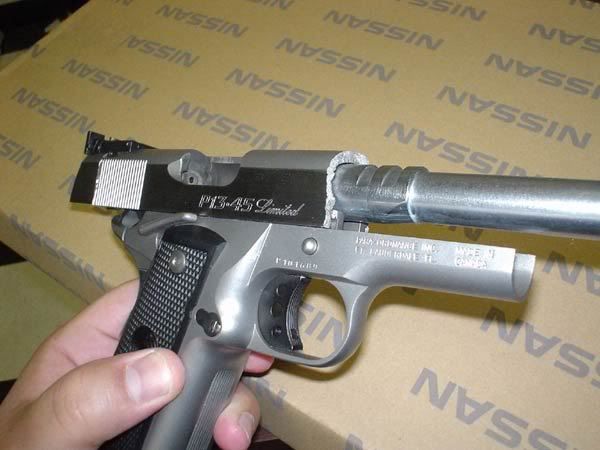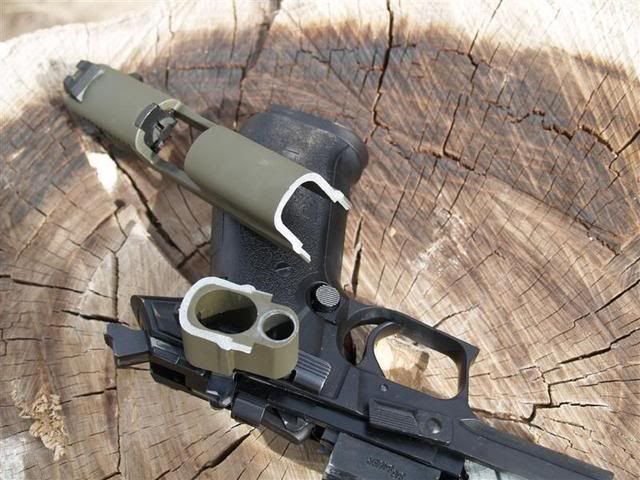You are using an out of date browser. It may not display this or other websites correctly.
You should upgrade or use an alternative browser.
You should upgrade or use an alternative browser.
Forged we know is great ... but what about CAST?
- Thread starter LouPran
- Start date
Many forged parts (almost all) start life as cast.
The forging process to produce the final shape makes the castings more uniform and tougher.
Any small voids in a casting tend to be flattened out during forging, and metal displacement makes for a very uniform 'grain' to the metal.
Casting can be suitable for parts that receive less loading, the same with MIM.
Neither is as good under impact loading as forged parts though.
Think of forging as impact loading during manufacture.
A part with internal flaws is likely to break up during forging and be discarded.
Casting and MIM might be more suitable for 1911 parts like a thumb safety that has minimal impact loading.
It is not as desirable for a hammer that repeatedly strike a firing pin and firing pin stop every time the gun is fired.
Well done MIM will likely last as long as forged, but there are a lot more things to go wrong.
The forging process to produce the final shape makes the castings more uniform and tougher.
Any small voids in a casting tend to be flattened out during forging, and metal displacement makes for a very uniform 'grain' to the metal.
Casting can be suitable for parts that receive less loading, the same with MIM.
Neither is as good under impact loading as forged parts though.
Think of forging as impact loading during manufacture.
A part with internal flaws is likely to break up during forging and be discarded.
Casting and MIM might be more suitable for 1911 parts like a thumb safety that has minimal impact loading.
It is not as desirable for a hammer that repeatedly strike a firing pin and firing pin stop every time the gun is fired.
Well done MIM will likely last as long as forged, but there are a lot more things to go wrong.
Ruger has been casting parts for ages - their cast frame revolvers are highly regarded for their strength and durability. As an owner of two, I'd say you would be hard pressed to find a stronger or more robust wheel gun then a GP100.
Investment casting is a pretty tried and true method of fabrication for gun parts, IMO (Essex and Caspian auto-loader frames and slide are cast, I think).
Investment casting is a pretty tried and true method of fabrication for gun parts, IMO (Essex and Caspian auto-loader frames and slide are cast, I think).
thinkingman
New member
I have more confidence in MIM and forging than cast.
$.01
$.01
The frames of a lot of gun makers are cast - see this thread
http://www.thefiringline.com/forums/showthread.php?t=187285
Nothing wrong with cast frames from a well regarded company with good QC.
http://www.thefiringline.com/forums/showthread.php?t=187285
Nothing wrong with cast frames from a well regarded company with good QC.
Reason I ask is , I discovered that Dan Wesson frames are cast metal ... at least some of the ones I looked at. And IMO cast metals can be just as bad or worse when it comes to strength , as MIM.
It appears they cast the frames and forge the slides only.
Not true for the DW Valor.
"Other features include forged frame with 25 LPI checkering and undercut trigger guard, adjustable defensive night sites, and Slime line VZ grips as well as all the other premium small parts you have come to expect from Dan Wesson."
http://www.cz-usa.com/product_detail.php?id=86
That's why I said at least some of the ones I looked at ... which are the Pointman Seven and the Bobtail ... both of which I confirmed use cast frames and forged slides.
Notice also the Valor is $3-400 more.
One thing I have always shy'd away from is having dissimilar strength metals in mated moving parts paired. The weaker metal will sometimes be broken down by the stronger.
Notice also the Valor is $3-400 more.
One thing I have always shy'd away from is having dissimilar strength metals in mated moving parts paired. The weaker metal will sometimes be broken down by the stronger.
Sturmgewehre
New member
I don't think this is much of an issue really. If this were an issue worthy of concern, then how do you explain the success of pistols like the M9, Sig P22x, 1911's with alloy frames, etc.? They don't seem to suffer from premature wear due to the dissimilar material of their frames and slides.One thing I have always shy'd away from is having dissimilar strength metals in mated moving parts paired. The weaker metal will sometimes be broken down by the stronger.
I have a Beretta Model 92 with 15,000+ rounds through it and there is barely any sign of wear on the slide rails... the top is steel while the frame is aluminum.
With that being said, I'm not real keen on cast frames on 1911's - period. I can't cite any particular reason for this dislike, but I avoid them regardless.
I think the cast vs. forged debate rages mostly around the 1911-style of pistol, as the gun was designed to be forged and fully machined, and there is concern that a gun of exactly those dimensions, made via casting, might not be as strong. Other guns on the market, such as the already mentioned Ruger revolvers, were designed from the get-go to be made via the investment casting process, so all of the dimensions and contours could be optimized with casting in mind; not so for a cast 1911. That said, again, as already noted, Caspian 1911 frames are cast, and they have as good a reputation as anyone in the business. Caspian used to make frames fully machined from barstock, and while they were beautiful, they were quite expensive compared to the cast frames, and they had a couple returned due to defects, when they'd never had a cast frame returned for a similar reason.
Stevie-Ray
New member
Eeeeeewwww!Slime line VZ grips
Forging and casting are both old metal forming methods dating many years ago. Because of metallurgical knowledge at the time, forging did produce a stronger, more durable product. However with the advances in metallurgy in the last 100 years, cast products are suitable for use in firearms. A lot to the myth comes from production of Colt firearms which were manufactured, up until fairly recently, on old equipment using old technology.
HisSoldier
New member
"Many forged parts (almost all) start life as cast."
Is someone casting close to finish dimension and then forging now?
Hmm, unless they don't forge gun parts the way they forge wrenches and hammers then that's true only in a very far off sense. Steel is cast I believe into large billets which are rolled over and over until they are a tiny fraction of the original section size. These rolled steel bars are sent to the gun manufacturer. (I know, Colt has their own steel division.) Then chunks are cut off, soaked in a furnace until bright red and struck with a forging die which forms the shape within some percentage of finished shape, after which it's machined. Often it's machined after heat treatment instead of being heat treated after machining to avoid warpage.
Industry uses cast steel for large highly stressed parts in which failure is not acceptable, cast steel is a whole 'nother thing from cast iron, it's homogeneous and if cast in a vacuum or a centrifuge there shouldn't be any porosity. The strength of cast steel should be very close to that of forged steel.
I would dearly love to watch the gun forging process. But I believe there's not much difference in the end product's strength or wear resistance between the two.
Is someone casting close to finish dimension and then forging now?
Hmm, unless they don't forge gun parts the way they forge wrenches and hammers then that's true only in a very far off sense. Steel is cast I believe into large billets which are rolled over and over until they are a tiny fraction of the original section size. These rolled steel bars are sent to the gun manufacturer. (I know, Colt has their own steel division.) Then chunks are cut off, soaked in a furnace until bright red and struck with a forging die which forms the shape within some percentage of finished shape, after which it's machined. Often it's machined after heat treatment instead of being heat treated after machining to avoid warpage.
Industry uses cast steel for large highly stressed parts in which failure is not acceptable, cast steel is a whole 'nother thing from cast iron, it's homogeneous and if cast in a vacuum or a centrifuge there shouldn't be any porosity. The strength of cast steel should be very close to that of forged steel.
I would dearly love to watch the gun forging process. But I believe there's not much difference in the end product's strength or wear resistance between the two.
Sturmgewehre
New member
Investment cast...Neither is as good under impact loading as forged parts though.
Think of forging as impact loading during manufacture.
A part with internal flaws is likely to break up during forging and be discarded.

Forged...

...et tu, Sig?

ElectricHellfire
New member
Yikes! Sturm, those are catastrophic! I despise MIM and cast parts of any type myself.
Sturmgewehre
New member
Actually, I have no problem with MIM parts in 1911's. Hammers, slide stops, safeties, grip safeties... nary a problem. Not my first choice, but I've owned guns with MIM in the for years (S&W autos and revolvers, Sig, Beretta, HK, etc.) and never had one break. I've never known anyone in real life who had a MIM part break. They're in everything... and just about every modern gun.
Here's a thread from another forum that covers the topic pretty thoroughly.
http://www.thehighroad.org/showthread.php?t=20673
http://www.thehighroad.org/showthread.php?t=20673
HisSoldier
New member
I asked the metallurgist that is employed by a steel supplier we use. He said that given a choice he would always choose forged if everything else was equal, but that wouldn't be his major priority in a firearm.
